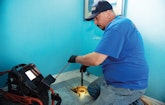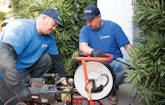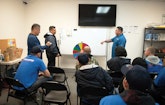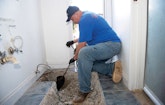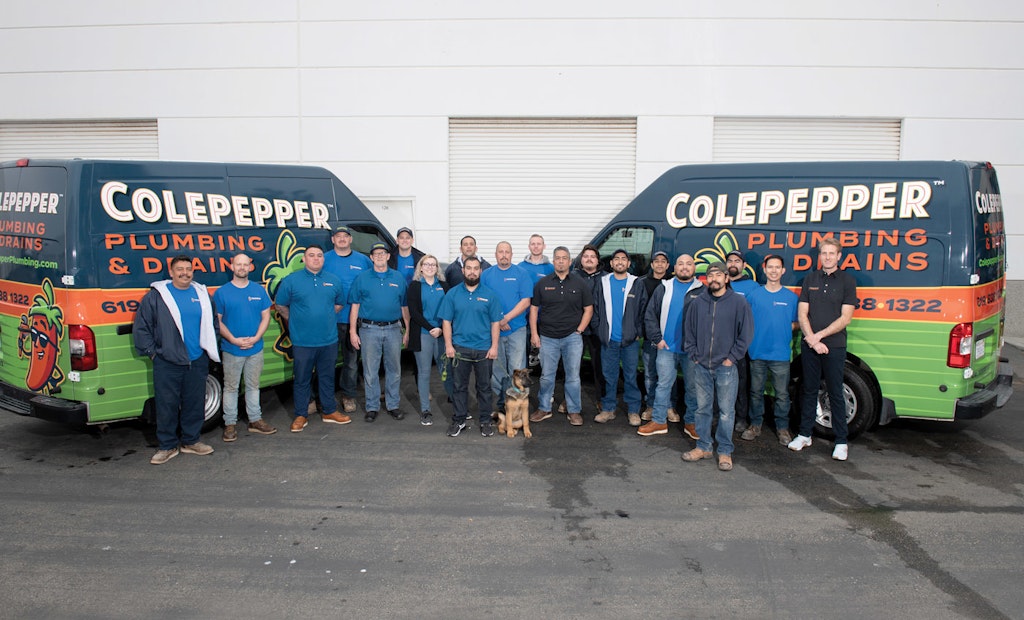
San Diego-based Colepepper Plumbing & Drains separates sales from fulfillment and lets technicians and the sales team each focus on their strengths.
Interested in Cleaning?
Get Cleaning articles, news and videos right in your inbox! Sign up now.
Cleaning + Get AlertsMany factors have contributed to the dramatic and rapid growth at Colepepper Plumbing & Drains, which morphed from a one-man operation into a multimillion-dollar-a-year enterprise since its inception in 2014.
But to owner Mitch Kenney, it all essentially boils down to three simple business strategies: Charge premium service rates. Hire people who know how to sell those services. And use the company’s trucks and radio ads to project a brand image that makes the phone ring.
In addition, the San Diego-based company aims to dramatically increase its drain cleaning business, which currently generates about 50% of the company’s revenue. Kenney would like to see higher-margin drain work eventually produce 70% of the company’s revenue.
“If customers use us to clean their drains, there’s a good chance they’ll use us for plumbing, too,” he says.
Some plumbers might scoff at the notion that a company can succeed by charging substantially more than competitors, or that hiring salespeople is a worthwhile expenditure, or that building brand recognition should be a top priority.
Nonetheless, it’s difficult to argue with the results at Colepepper. Kenney started out with one truck in 2014; by 2018, he was running 16 service trucks. Employment grew from one to 24. And gross revenue roughly doubled every year, he says.
Furthermore, the company moved into a new 1,800-square-foot facility in 2017. And it doesn’t appear as though the rapid growth has affected customer service; the company currently has a 4 1/2-star rating out of a possible five stars on Google reviews, based on more than 325 reviews.
Unforgettable trucks
The company’s 16 service vehicles — mostly Nissan NV2500 high-roof cargo vans — are the linchpins in the company’s branding campaign. Kenney, 34, opted for the Nissans for several reasons, including their warranties and reliability.
But he also liked their taller bodies, which provide more room for parts and equipment; each truck carries about $10,000 worth of repair parts and other items. They also provide more space for advertising.
“The taller roofs make them more visible,” he says. “Think about how much companies are willing to pay for a billboard located alongside a freeway. These trucks essentially are rolling billboards.”
Furthermore, Kenney hired a marketing firm in 2019 to develop a more memorable visual brand for the company. A designer at the firm felt an animated mascot would stand out compared to other plumbing trucks in the market. The result is a play on the company’s name: A hip, friendly looking hot pepper, wearing a smile and sunglasses and wielding a pipe wrench.
“He’s kind of cute and cuddly,” Kenney says. “We call him ‘Mr. Colepepper.’ He gives off a very positive vibe.”
Then Kenney invested in vinyl wraps featuring the pepper and a striking color combination of black, green and orange. Before, Colepepper trucks were orange, which Kenney describes as noticeable, but not really memorable.
“But now that they’re rebranded with the new pepper logo, our trucks get noticed big-time,” he says, noting that more and more customers now tell dispatchers that seeing the trucks prompted them to call. “We never really used to hear that before.”
Spend money to make money
The price of visibility is not cheap: $15,000 for design services and another $50,000 for the vinyl wraps. But Kenney says he knows it’ll pay for itself in the long run, if it hasn’t already done so.
“If people remember us, then it shows we’re top of mind in terms of awareness,” he says. “That’s what it’s all about when you’re building a brand. But it takes time, too — that phone doesn’t start ringing right away.”
A third-generation plumber (his father and grandfather were plumbers), Kenney concedes that his approach to branding isn’t for everyone. “It all depends on your goals,” he says. “If you want to stay small, then you really don’t need to build a brand — it’s probably a waste of money.
“But if you want to be a household name like I do, then you need to shift over to building a brand,” he continues. “My goal is to be omnipresent in the San Diego market.
“We need to build a brand because, in this industry, customers tend to commoditize plumbing (choose contractors based on only price),” he adds. “But since we charge premium prices, we need to build a brand that people like and feel good about. … And that can help overcome price objections.”
A new path
Kenney never planned to be a plumber and drain cleaner. While growing up in Denver, he worked for his father and at one time considered taking over the family business upon his dad’s retirement. But that didn’t pan out, so in 2008, he took a different path.
“I tried to make money in different ways over the years,” he says. “I had minor success, but nothing noteworthy. … I wasn’t even sure I wanted to stay in plumbing. But eventually I decided I had to pick one thing and focus on it. And I decided that plumbing had the biggest upside.”
So in 2014, he established Colepepper as a part-time venture that quickly turned into a full-time job. (The company’s name comes from his father’s surname; Kenney thought Colepepper Plumbing sounded better than Kenney Plumbing.)
Kenney says a lot of his business knowledge came from working for larger, successful companies and observing what they did right. And a big part of that was pricing services high enough to account for their costs and providing high-enough profit margins to plow money back into their businesses.
Too many contractors base their rates on what everyone else is charging. Or they have only a vague idea of what their costs are and subsequently don’t charge enough to be able to pay employees well or invest in newer, more productive tools and equipment and nice-looking service vehicles, he says.
“For most guys, it’s a crapshoot. If you don’t know how to price things, find someone who can help you do it. Single-digit profit margins are fairly common in this industry. But we help protect the health of this country. Why should we settle for 5% profit margins?”
Kenney says he aims for a 35% net profit margin. “We’re currently not achieving that, but it’s our goal.”
Serious selling
To generate significant revenue that, in turn, results in substantial profit margins, technicians are trained to thoroughly inspect homes for possible major problems. For a clogged sink drain, for instance, technicians always examine the line with a pipeline inspection camera. But they also then inspect as many other drainlines in the home as possible, including sewer laterals, to uncover potential problems, Kenney says.
If technicians identify a serious pipe problem that requires a whole-house repipe, for instance, or (trenchless) pipe rehab using pipe lining or epoxy-spray technology, one of the company’s two salesmen visits the job site. It takes professional communicators to sell expensive projects like these, and overcome price objections, Kenney says. (The company currently subcontracts pipe lining and epoxy-spray services.)
“Like many industries, we’ve decided to separate sales from fulfillment,” he explains. “We let the technicians (the fulfillment side) do what they are great at, which is the technical part of the job. And on the sales side, we develop and seek out professional communicators and relationship builders to do what they are great at, which is to generate sales.”
To prevent price objections, technicians and salesmen are trained to let customers know in advance that Colepepper charges more than the average plumber. But here’s the key: They also explain why, pointing out things like technicians’ experience, the technology they use, their ability to do jobs right the first time, how clean they leave job sites and how fast they complete projects, as opposed to contractors that start a job, leave for a week and then return.
“We also offer a lifetime warranty on our work, which is huge for combatting price objections,” he adds. “So if we mess up and something fails prematurely, the customer is covered for life. And if customers say they don’t need a lifetime warranty, we use it as a negotiating tool — say, drop it down to a five-year warranty in exchange for a lower price.”
Some plumbers charge lower prices because they want to gain the proverbial “customer for life.” But Kenney says that philosophy isn’t always valid, citing studies that show after 12 months most customers don’t call the same contractors over and over, no matter how pleased they are with the work performed.
“It’s not that we don’t want customers for life,” he explains. “We’re just facing the reality that the odds of them doing business with us, no matter how much they like us, go way down after 12 months from their initial purchase. This has been proven by a lot of sophisticated testing and surveying.
“It’s easier to retain long-term business with a low-cost business model, but it’s harder with a high-cost model like ours.”
Emphasis on drains
Looking ahead, Kenney sees a continued shift toward cleaning drains, which is more profitable than plumbing repairs.
To clean larger drains, the company owns a Brute cart-mounted water jetter (9 gpm at 4,000 psi) made by Jetters Northwest, with nozzles made by StoneAge, Enz and US Jetting.
The company also owns Super Midi Miller and Mini Miller drain machines built by Picote Solutions. Service trucks carry drum cable machines manufactured by Gorlitz Sewer & Drain, one for small drains and one for mainlines. For inspecting drainlines, the company owns seven RIDGID SeeSnake standard, Mini and nanoReel pipeline cameras.
“We’d like to own the drain cleaning market here in San Diego,” he says. “We want to be the No. 1 company people think about when they have a clogged drain.”
In five years, Kenney’s goal is to have 100 service trucks and open another location, perhaps in the Southwest or in Florida. To him, it’s just a matter of repeating what the company currently is doing in terms of branding, pricing and selling.
“Right now we’re slowing down a bit and shoring up our processes — making sure we have a strong foundation and good margins,” he says. “I want to get really good at developing repeatable processes so we can easily scale them in other locations. If we can make it work here (in a tough state regulatory climate), we can make it almost anywhere.”
Creating a bond with customers
At Colepepper Plumbing & Drains in San Diego, an integrated marketing campaign that centers on eye-catching new vinyl wraps for service trucks also includes another important branding element: radio advertising.
Since April 2019, the company has run roughly 300 30-second radio ads a month, aimed at raising the company’s profile for drain cleaning services. Mitch Kenney, company owner, declines to say how much the company spends on radio ads, but notes that it works.
“It’s a lot of money,” he says. “But we know it’s been successful because we always ask customers how they heard about us.”
Kenney decided to invest in radio advertising because he heard how successful it could be both from speakers at seminars and from his experience at other plumbing companies. He believes his company’s ads make the company’s phones ring because they create a likeable image for the company that’s relatable to the average customer, as opposed to ads that do little more than tout a company’s abilities.
“We call it customer bonding,” he explains. “Most companies use typical ad speak: ‘We’re Joe’s Tile. We’re the best tilers on the planet, and we’ve been doing it since 1952,’ for instance. Most people just tune out stuff like that. But our ads don’t sounds like your typical radio ads.”
Most of the ads are humorous and center on two things: a $71 drain cleaning special aimed at getting customers to call or Kenney talking with his 7-year-old daughter, Brooklynn, who plays the role of an aspiring drain cleaner. “She’s adorable,” Kenney says. “You can’t go wrong with kids in ads.”

